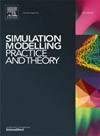通过实验和模型对长距离楼梯向下疏散速度的新认识
IF 3.5
2区 计算机科学
Q2 COMPUTER SCIENCE, INTERDISCIPLINARY APPLICATIONS
引用次数: 0
摘要
目前的超高层建筑疏散模型通常假设一个固定的速度或随着移动距离的增加而降低速度,忽略了体力消耗、休息后恢复和伙伴行为的综合影响。在本研究中,我们通过实验和模型对长距离楼梯的向下疏散速度提出了新的见解。首先,以目标距离、休息、是否搭档为控制因素,进行长距离下楼实验。其次,根据实验结果,定义速度随累积距离的减小以及剩余距离后速度增加多少的速度公式。在此基础上,建立了超高层建筑的动态速度疏散模型(evacd - ds模型),其中行人的速度由定义公式中考虑的因素决定,如预期疏散距离、疏散时间、休息时间、目标距离、是否搭档等。结果表明,无论是单独行走还是成对行走,用evaca - ds模型预测的长距离楼梯疏散过程中的速度变化趋势与实验结果吻合较好。最后,利用evaca - ds模型对高度为580m的上海中心大厦进行了疏散过程模拟,并将预测速度与疏散演练数据进行了比较,并对速度随距离线性降低和速度恒定的两种模型进行了比较。结果表明,该模型能够有效地预测实际超高层建筑中行人的疏散时间和疏散速度的变化。本研究可为理解长距离楼梯间行人疏散过程中速度的非线性变化提供关键的一步,为超高层建筑楼梯间行人疏散的理论研究和模型应用提供科学的参考和支持。本文章由计算机程序翻译,如有差异,请以英文原文为准。
New insights on the downward evacuation speed on long-distance stairs by experiment and modelling
Current evacuation models for super high-rise buildings typically assume a fixed speed or a decrease in speed with distance traveled, which overlooks the combined effects of physical exertion, recovery after rest, and partnering behavior. In this study, we present new insights on the downward evacuation speed on long-distance stairs by experiment and modelling. First, long-distance down stairs experiments are carried out, in which the goal distance, rest, and partnering or not are used as control factors. Second, a speed formula that indicates how the speed decreases as accumulated distance and how much does the speed increase after the rest is defined according to the experimental results. Furthermore, an evacuation model with dynamic speed (Evac-DS model) for super high-rise buildings is built, in which the pedestrian's speed is determined by the factors considered in the defined formula, such as expected evacuation distance, evacuation time, rest time, goal distance, and partnering or not. The results show that whether in scenarios where pedestrians move alone or in pairs, the trend of speed changes in the evacuation process on long-distance stairs predicted by the Evac-DS model closely matches the experiment. Finally, the Evac-DS model is used to simulate the evacuation process in Shanghai Tower with 580m height, and the predicted speed is compared with the evacuation drill data, as well as two other models: one assuming a constant speed and another where speed decreases linearly with distance. The results indicate that the Evac-DS model can effectively predict the evacuation time and the variation of pedestrian's evacuation speed in actual super high-rise buildings. This study may be a key step in understanding the nonlinear changes in speed during long-distance stairs evacuation, and provide scientific reference and support for both theoretical research and model applications related to pedestrian evacuation in the stairwells of super high-rise buildings.
求助全文
通过发布文献求助,成功后即可免费获取论文全文。
去求助
来源期刊

Simulation Modelling Practice and Theory
工程技术-计算机:跨学科应用
CiteScore
9.80
自引率
4.80%
发文量
142
审稿时长
21 days
期刊介绍:
The journal Simulation Modelling Practice and Theory provides a forum for original, high-quality papers dealing with any aspect of systems simulation and modelling.
The journal aims at being a reference and a powerful tool to all those professionally active and/or interested in the methods and applications of simulation. Submitted papers will be peer reviewed and must significantly contribute to modelling and simulation in general or use modelling and simulation in application areas.
Paper submission is solicited on:
• theoretical aspects of modelling and simulation including formal modelling, model-checking, random number generators, sensitivity analysis, variance reduction techniques, experimental design, meta-modelling, methods and algorithms for validation and verification, selection and comparison procedures etc.;
• methodology and application of modelling and simulation in any area, including computer systems, networks, real-time and embedded systems, mobile and intelligent agents, manufacturing and transportation systems, management, engineering, biomedical engineering, economics, ecology and environment, education, transaction handling, etc.;
• simulation languages and environments including those, specific to distributed computing, grid computing, high performance computers or computer networks, etc.;
• distributed and real-time simulation, simulation interoperability;
• tools for high performance computing simulation, including dedicated architectures and parallel computing.
 求助内容:
求助内容: 应助结果提醒方式:
应助结果提醒方式:


